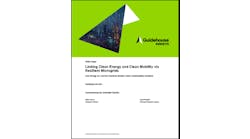Siemens’ Clark Wiedetz highlights a different way to approach wildfires. Explore why many businesses are taking a look at alternative solutions to a growing number of natural disasters, like microgrids for wildfires.
Clark Wiedetz, director of microgrids and renewable integration, Siemens Digital Grid
Over the last several decades, the western United States has become a region of widespread, high-intensity wildfires. Specifically, since the 1970s, the western U.S. has experienced three times the amount of “large fires” (fires that burn 1,000 acres or more) that are now burning on average more than 1.7 million acres of land per year. The region has also experienced wildfire seasons that are 78 days longer than they were in 1970. It has been found that throughout the whole United States, 84% of these wildfires are started by humans.
The problem has been complicated by climate change, forest management, outdated and neglected electrical infrastructure, and local land-use decisions that allow communities to sprawl deeper into fire-prone areas.
Being prepared for the wide array of urgent issues and problems that can arise during severe weather and other emergencies is not easy for electric utilities. Their widely dispersed equipment and infrastructure creates possible points of vulnerability.
Case Study: Blue Lake Rancheria’s intelligent microgrid management system
Blue Lake Rancheria is a century-old Native American reservation in Northern California equipped with a low-carbon community microgrid to help power government offices, economic enterprises, and critical Red Cross safety shelter-in place facilities across 100 acres. The microgrid includes a 500-kilowatt solar photovoltaic system and a 1,000-kWh Tesla battery storage system, all managed and controlled with a microgrid management system. The microgrid uses decentralized energy resources and intelligent software to provide its residents and economic enterprises with reliable power without interruption. In fact, the Rancheria achieved 100% resiliency during the recent Shasta and Trinity Counties ‘Carr Fire’ in the summer of 2018 by utilizing its microgrid management system to enable the six following benefits:
(Graph: Courtesy of Siemens)
Siemens’s holistic portfolio provides the fastest way to achieve these results. This project incorporates the largest solar array in currently in operation in Humboldt County (California), saves Blue Lake Rancheria over $200,000 in annual energy costs, reduces at least 150 tons of carbon per year, and has grown clean energy jobs by 10 percent.
A new report from Siemens explores how with robust microgrid and emergency power supplies, critical infrastructure can continue to serve thousands of people with life, health and safety services. Learn more about how microgrids for wildfires can increase resiliency for today’s businesses.
Clark Wiedetz is director of microgrids and renewable integration for Siemens Digital Grid.







